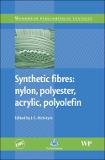| dc.contributor.author | Edited by McIntyre, J. E. | |
| dc.date.accessioned | 2022-05-26T05:19:43Z | |
| dc.date.available | 2022-05-26T05:19:43Z | |
| dc.date.issued | 2005 | |
| dc.identifier.citation | Edited by McIntyre, J. E. (2005). Synthetic fibres: nylon, polyester, acrylic, polyolefin. Cambridge : Woodhead. | en_US |
| dc.identifier.isbn | 1 85573 588 1 | |
| dc.identifier.uri | http://hdl.handle.net/123456789/1457 | |
| dc.description.abstract | Synthetic fibres account for about half of all fibre usage, with applications in every field of fibre and textile technology. Although many classes of fibre based on synthetic polymers have been evaluated as potentially valuable commercial products, four of them - nylon, polyester, acrylic and polyolefin - dominate the market. These four account for approximately 98% by volume of synthetic fibre production, with polyester alone accounting for around 60%. | en_US |
| dc.language.iso | en | en_US |
| dc.publisher | Woodhead | en_US |
| dc.subject | Synthetic fibres | en_US |
| dc.title | Synthetic fibres: nylon, polyester, acrylic, polyolefin | en_US |
| dc.type | Book | en_US |







